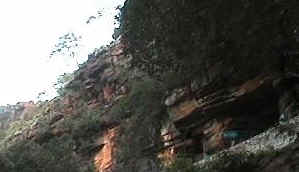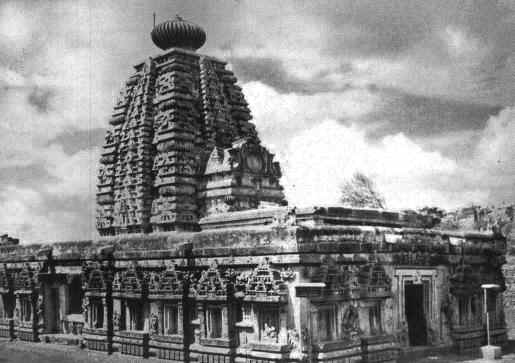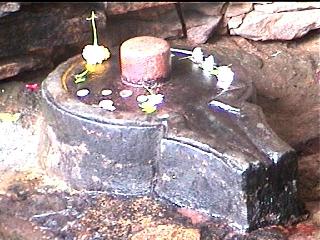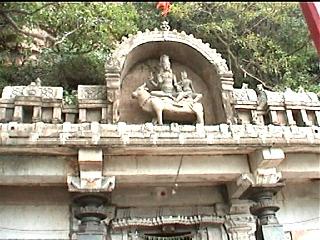

Points of Interests in Mahabubnagar
Explore Mahabubnagar District
Places in Mahabubnagar District
Mahabubnagar , around 96 Kms from Hyderabad, is well connected by road and rail with all important towns and cities in the State.
Pillalamari : The famous 500 yr. old Banyan tree here, covering an area of over four acres, can accommodate about 1000 people in its shade. People gather here for picnics and celebrations. The shrine of a Muslim saint under this tree. Story of Pillalamarri.
Alampur : Alampur is on the banks of the River Tungabadra, has numerous antiquities belonging to the Chalukyan period. The plan and carvings of the two groups of Brahmeswara and Papanatha Temples here, closely resemble the rock cut temples of western India.
Umamaheswaram is located at a distance of 150 KM from Hyderabad and close by Achampet in Mahabubnagar District. Umamaheswaram temple is situated on very tall hills of Nallamala forests and dates back to 2nd century A.D. To reach the temple, one has to ride on very steep and dangerous curves of 5 mile length from the bottom of the hill. It is well known as North Entrance to Srisailam (Jyotirlingam). Umamaheswaram temple is in deep Nallamalai forests and located in vast range of Scenic mountains. Umamaheswaram is popular for it's Misterious papanashanam where you can always find a mug of water what ever you take out from it throughout the year. Nobody could find from where this water is coming. Till today it is the home for innumerous Sadhus. The presiding deities in Umamaheshwaram are Mallikarjuna (Shiva) and Bhramaramba (Devi).
Worlds's largest Tiger Sanctuary (Mannanur): Dry deciduous mixed forest along the river Krishna which cuts through a picturesque gorge of the Nallamalai hills with deep valleys on sides. The sanctuary with a wide area of 3568 Sq. km. spanning Guntur, Prakasam, Kurnool, Mahabubnagar, Nalgonda districts. About 130 km. south of Hyderabad. Animals found: Spotted Deer, Mouse Deer, Black Bucks, Sambhars, Chousingha Nilgai, Wild Boar, Indian Giant Squirrel, Tree Shrew, Rayel, Mugger Crocodiles, Wild dogs, Jackals, Wolves, Foxes, Sloth Bear, Panthers, Tigers. Accessibility: 130 km. by road from Hyderabad. Well connected with State owned buses. Contact: Field Director, Project Tiger, Achampet/Srisailam Season: October to May.
Farahabad : Farahabad is an altitude of 914 Mts. in the Nallamalla Hills in the Eastern Ghats. This holiday resort enjoys a salubrious climate. It has been most appropriately named Farahabad, which literally means 'Mount Pleasant'.
Gadwal : Gadwal town , between the Krishna and Tungabadra Rivers, is noted for the harmonious coexistence here of the cultures A.P and Karnataka. Gadwal is also famous for its handloom weaving industry. Gadwal silk saris, with exquisite zari work command a good market through out the country.
Koilsagar Project : The Koilsagar Dam, about 8 km from koil konda village, stretches across the Peddavagu, a minor tributary of the Krishna River. The western stretch of this picturesque reservoir is surrounded by high hills, making it a beautiful spot.
Monikonda : The Lakshmi Venkateswara shrine is on a 915 Mts. high hill that is 2 km from the village.
Wanaparthi : The ancient shrine of Vittaleswara is located here. The Sarlasagar project nearby features the biggest syphon dam in the world.
Bala Nagamma (Aidamma):This famous ancient place has perched a conveted place in the temple history due to its association with the infinitely popular Balanagamma folk lore story popularised by the Burrakatha artistes akin to Harikatha bhagavathothamas. The goddess Aidamma played a spectacular role and established for herself a permanent place due to demonstration of her sports . She is popular as vgery compassionate goddess. Who rescues her aborers from the clutches of the Satanic forces. If they rely upon her and her bounty after offering soulful prayers. She reveals her dreadful aspect and is appeased with animal sacrifice most On account of enjoying her munificence and freed from the unending worries, she is adored passionately by rural folk. And festivals are celebrated with great eclat. Regual daily pujas, and the annual festival falling in the month of Sravana lure huge crowds, who are lustily participating in special prayer services to excpress their devotion to her. It lies in the Vanaparthi taluq of Palamur district of Andhra Pradesh, accesible by bus.
Alampur:
Alampur near Kurnool is home to the very ancient Navabhramma temples dating back to the 7th century CE. Alampur is located at a distance of 200 km from Hyderabad. Alampur is considered to be the western gateway of Sree Sailam, the revered Jyotirlinga Shivastalam in Andhra Pradesh. The southern, eastern, and northern gateways are Siddhavattam, Tripurantakam and Umamaheswaram respectively.
The Tungabhadra and Krishna are in confluence near Alampur, which is also known as Dakshina Kailasam (as is Sree Kalahasti in Southern Andhra Pradesh). Nine temples here referred to as the Nava Bhramma temples are dedicated to Shiva.

The Nava Bhramma temples were built by the Badami Chalukyas, who ruled for about 200 years from the middle of the sixth century onwards. The Badami Chalukyas built several temples in Karnataka, and the Alampur temples in Andhra Pradesh.The Alampur site preserves archeological remains in the form of temples exhibiting a hybrid style of architecture - dating back to the 6th-7th centuries CE. Some of the images from this site are also housed in a museum nearby.
The Nava Bhramma temples are Taraka Bhramma, Swarga Bhramma, Padma Bhramma, Bala Bhramma, Garuda Bhramma, Kumara Bhramma, Arka Bhramma, Vira Bhramma and the Vishwa Bhramma. These temples are all enclosed in a courtyard on the left bank of the river Tungabhadra.
The Bala Bhramma temple is the principal shrine of worship. It dates back to the year 702 CE - per the inscriptions seen here. Shivaratri is celebrated in great splendour here.
The Taraka Bhramma temple is partly in ruins, and it has no image in the sanctum. It bears telugu inscriptions from the 6th-7th century CE. The Swarga Bhramma temple with an imposing tower is considered to be among the finest in Alampur, and is an excellent specimen of Chalukyan architecture and sculpture. It contains several sculptures in bas relief, and it dates back to the end of the 8th century.
The Padma Bhramma temple partly in ruins, contains a Shivalingam of clear stone with mirror like finish. The Viswa Bhramma temple is among the most artistic of the Nava Bhramma temples. The sculptural work here depicts scenes from the epics.
Also in the enclosed courtyard is located the Suryanarayana temple, dating back to the 9th century. This temple has bas reliefs representing the incarnations of Vishnu. There is also a Narasimha temple with inscriptions from the period of Krishna Deva Raya of the Vijayanagar Empire.
Near Alampur, is Papanasam with a cluster of over 20 temples of varying sizes and styles. The most important of these is the Papanaseswara temple.
Uma Maheswaram (Home of Parvathi and lord Siva):


Umamaheswaram is located at a distance of 150 KM from Hyderabad and close by Achampet in Mahabubnagar District. Umamaheswaram temple is situated on very tall hills of Nallamala forests and dates back to 2nd century A.D. To reach the temple, one has to ride on very steep and dangerous curves of 5 mile length from the bottom of the hill. It is well known as North Entrance to Srisailam (Jyotirlingam). Umamaheswaram temple is in deep Nallamalai forests and located in vast range of Scenic mountains. Umamaheswaram is popular for it's Misterious papanashanam where you can always find a mug of water what ever you take out from it throughout the year. Nobody could find from where this water is coming. Till today it is the home for innumerous Sadhus.
The presiding deities in Umamaheshwaram are Mallikarjuna (Shiva) and Bhramaramba (Devi).
|
GADWAL It is famous for
handloom weaving industry. Gadwal sarees are popular for their exquisite
silk and zari work. Gadwal is one of the
centers where a typical, traditional Andhra saree is made. These sarees
are unusual, different and dignified. It’s body is cotton while the
border and pallu are in silk. They are woven separately and attached later
on. Rich traditional designs adorn both the border and the pallu. Mango
motif is most popular in these designs. Yellow, parrot-green, pink and
beige are the most sought after colours in these sarees. |

|
|
Kothakota
Similar to Gadwal are the Kothakota range of cotton sarees with silk borders and rich pallus and also innovative zari designs. Borders are always in rich colours contrasting the body colour. |

|
| NARAYANPET
Narayanpet sarees are very popular as
traditional wedding sarees. They blend native tradition with the art of
classical weavers of Varanasi. These sarees have intricately designed
pallus and simple borders in contrasting colours. The sarees are famous
for their mixed colours like pink with purple or maroon with mustard.
Cotton-silk blends and light pure silks are their speciality. |
 |
X¾ªÃu-{¹
ꢓŸ¿¢’à ¦µÇ®Ï-©Õx-ÅŒÕÊo X¾ª½-£¾É-¦ÇŸþ
ÆÍŒa¢-æX{, Æ“«Ö-¦ÇŸþ,
ÆÂîd-¦ª½Õ 14 (ÊÖu®ý-{Õœä): “X¾Â¹%A ®¾¢X¾-Ÿ¿Â¹× X¾ÛšËd-E-©x-ªáÊ
Ê©x-«Õ© Æ{O “¤Ä¢ÅŒ¢ ÅŒÊ ²ò§ŒÕ-’Ã-©Åî “X¾Â¹%A
“XϧŒá-©ÊÕ X¾ª½-«-P¢-X¾-èä-²òh¢C. ‡ÅŒh-ªáÊ Âí¢œ¿-©åXj
ÊÕ¢* ‡T-®Ï-X¾œä FšË Ÿ¿%¬Çu©Õ, ’¹© ’¹© ¤Äêª å®©-§äÕª½x
®¾«y-œ¿Õ©Õ, Í碒¹Õ Í碒¹ÕÊ ’¹¢Åä «Êu-“¤Ä-ºÕ©Õ,
Âí¢œ¿©Õ, ©ð§ŒÕ©Õ X¾ªÃu-{-¹×-©ÊÕ N¬ì-†¾¢’à ‚¹-{Õd-¹ע-{Õ-¯Ãoªá.
Ê©x-«Õ© Æ{OÆ¢ŸÄ-©ÊÕ “X¾Â¹%A “XϧŒá©Õ ‚²Äy-C¢Íä
NŸµ¿¢’à ªÃ†¾Z X¾ªÃu-{¹ ¬ÇȨ “¤Ä¢ÅÃEo ÆGµ-«%Cl´
Í䧌Õ-šÇ-EÂË ¡Âê½¢ ͌՚Ëd¢C. å£jÇŸ¿-ªÃ-¦Ç-ŸþÐ-¡-¬ëj©¢
“X¾ŸµÄÊ ª½£¾Ç-ŸÄ-JåXj X¾ªÃu-{¹ ¬ÇÈ ‚Ÿµ¿y-ª½u¢©ð
NNŸµ¿ ÆGµ-«%Cl´ X¾ÊÕ©Õ ÍäX¾-œ¿Õ-ÅŒÕ-¯Ãoª½Õ. “X¾A ªîW
«¢Ÿ¿© ®¾¢Èu©ð X¾ªÃu-{-Â¹×©Õ Æ¹ˆ-œËÂË Í䪽Õ-ÂíE
殟¿ Dª½Õ-ÅŒÕ-¯Ãoª½Õ. X¾ªÃu-{¹ ¬ÇÈ ‚Ÿµ¿y-ª½u¢©ð
ª½Ö. 60 ©Â¹~© «u§ŒÕ¢Åî NNŸµ¿ ÆGµ-«%Cl´ X¾ÊÕ©Õ ÍäX¾-œ¿Õ-ÅŒÕ-¯Ãoª½Õ.
ƒX¾p-šËê X¾ª½-£¾É-¦ÇŸþ Æ{O “¤Ä¢ÅÃEo Æ¢Ÿ¿¢’Ã
BJaCŸÄlª½Õ. å£jÇŸ¿ªÃ-¦ÇŸþ ÊÕ¢* ¡¬ëj©¢ „ç@ìx “X¾ŸµÄÊ
ª½£¾Ç-ŸÄ-JåXj «ÕÊo-ÊÖª½Õ “’ëբ ÊÕ¢* 18 ÂË.OÕ.
“X¾§ŒÖ-ºË¢* ƹˆœË ÊÕ¢* Æ{O “¤Ä¢ÅŒ¢-©ð-EÂË 8 ÂË.OÕ.
Ÿ¿Öª½¢ „çRÅä X¾ª½-£¾É-¦ÇŸþ «®¾Õh¢C. ƒÂ¹ˆœ¿ Âí¢œ¿
*«J ¦µÇ’¹¢ …¢œ¿-{¢Åî ƹˆœË ÊÕ¢* C’¹Õ-«Ê …Êo
“’ë֩Õ, Æ{O “¤Ä¢ÅÃEo A©-ÂË¢-Íä¢-Ÿ¿ÕÂ¹× O©Õ’Ã
“X¾Åäu¹ \ªÃp{Õx Íä¬Çª½Õ. Æ{-O-¬ÇÈ ÊÕ¢* 20 ‡Â¹-ªÃ©
N®Ôh-ªÃgEo X¾ªÃu-{¹ ¬ÇÈ „ê½Õ MèüÂ¹× B®¾Õ-ÂíE ¨“¤Ä¢ÅÃEo
“X¾«áÈ X¾ªÃu-{¹ ꢓŸ¿¢’à BJa-C-Ÿäl¢-Ÿ¿ÕÂ¹× Â¹%†Ï
Í䮾Õh-¯Ãoª½Õ. 20 ‡Â¹-ªÃ© N®Ôh-ª½g¢©ð Æ{O “¤Ä¢ÅÃ-EÂË
åX¶Eq¢’û \ªÃp{Õ Íä¬Çª½Õ. å£jÇŸ¿-ªÃ-¦ÇŸþ ªÃ³ÄZEo EèÇ¢
“X¾¦µ¼Õ«Û ¤ÄL¢-*Ê Â颩ð Ê©x-«Õ© “¤Ä¢ÅŒ¢-©ðE X¾ª½-£¾É-¦Ç-ŸþÊÕ
„䮾N NœË-C’à „Ãœ¿Õ-Â¹×¯ä „Ãª½Õ. “X¾A \šÇ „䮾N
Â颩ð X¾ª½-£¾É-¦Ç-ŸþÊÕ ®¾¢Ÿ¿-Jz¢* ¯ç© ªîV©Õ
ƹˆœä …¢œË „äšÇœä „ê½Õ. ÆX¾pšðx EèÇ¢ “X¾¦µ¼Õ«Û
E„î¾¢ …¢œä¢-Ÿ¿ÕÂ¹× ÆAC± ’¹%£¾ÉEo EJt¢-Íê½Õ. ŠÂ¹
¦µ¼«Ê¢ X¾ÜJh’à PC±-©-„çÕi¢C. Æ{-O-¬ÇÈ ‚Ÿµ¿y-ª½u¢©ð
EJt¢-*Ê éª¢œ¿Õ ¦µ¼«-¯Ã-©ÊÕ “X¾®¾ÕhÅŒ¢ X¾ªÃu-{¹
¬ÇÈ „ê½Õ ²ÄyDµÊ¢ Í䮾Õ-ÂíE „ÚËE ÆGµ-«%Cl´
Íä¬Çª½Õ. ’¹ÅŒ¢©ð ÆX¾Ûp-œ¿-X¾Ûpœ¿Õ Âí¢Ÿ¿ª½Õ §ŒÖ“A-¹שÕ
«Ö“ÅŒ„äÕ ®¾¢Ÿ¿-Jz¢Íä „Ãª½Õ. ƒX¾Ûpœ¿Õ ÆGµ«%Cl´
Âê½u-“¹-«Ö©Õ ÍäX¾šËd ÅŒTÊ «®¾-ÅŒÕ©Õ \ªÃp{Õ
Í䧌Õ-{¢Åî “X¾A ªîW «¢Ÿ¿© ®¾¢Èu©ð ®¾¢Ÿ¿-ª½z-¹שÕ
«®¾Õh-¯Ãoª½Õ. TJ-•-ÊÕ© E„Ã-²Ä-©ÊÕ ÅŒ©-XÏ¢Íä NŸµ¿¢’Ã
’¹œËfÅî ¹ךÌ-ªÃ©Õ EJt¢* ®¾¢Ÿ¿-ª½z-Â¹×©Õ ¦®¾
Íä殢-Ÿ¿ÕÂ¹× «®¾A ¹Lp¢-Íê½Õ. ¦§ŒÕšË ÊÕ¢* ÍŒÖæ®h
Íç¢ÍŒÕ©Õ E„î¾¢ …¢œä ¦ïœ¿Õf ’¹ÕœË-å®-©ÊÕ ÅŒ©-XÏ¢Íä
NŸµ¿¢’à ÆN ¹E-XÏ-²Ähªá. ‚ ¹ךÌ-ªÃ©ðx X¾ªÃu-{-¹שÕ
E„î¾¢ …¢œä¢-Ÿ¿ÕÂ¹× ‚Ÿµ¿Õ-E¹ «®¾-ÅŒÕ©Õ \ªÃp{Õ
Íä¬Çª½Õ. ŠÂíˆÂ¹ˆ ¹ךÌ-ªÃ-EÂË ŠÂ¹ ªîVÂ¹× §ŒÖ“A-¹ש
ÊÕ¢* ª½Ö. 300 «®¾Ö©Õ Í䮾Õh-¯Ãoª½Õ. X¾ªÃu-{-¹ש N¯îŸ¿¢
Â¢ “X¾Åäu-¹¢’à §ŒÕ-©©Õ \ªÃp{Õ Íä¬Çª½Õ. XÏ©x-©Åî
¤Ä{Õ åXŸ¿l „ê½Õ Â¹ØœÄ §ŒÕ-©©ð ’¹ÕÅŒÖ “X¾Â¹%-AE
‚²Äy-C-®¾Õh-¯Ãoª½Õ. §ŒÖ“A-Â¹×©Õ Â¹Øªîa-«-šÇ-EÂË
“X¾Åäu-¹¢’à ƒ®¾Õ-¹ÊÕ ÅçXÏp¢* ¤òªá¢-Íê½Õ.
Âí¢œ¿ C’¹Õ« ¦µÇ’Ã-EÂË X¾ª½-£¾É-¦ÇŸþ 2 „ä© Æœ¿Õ-’¹Õ©
‡ÅŒÕh©ð …¢C. Âí¢œ¿ *«J ¦µÇ’ÃÊ X¾ªÃu-{-Â¹×©Õ E©-¦œË
C’¹Õ« “¤Ä¢ÅÃEo A©-ÂË¢-Íä¢-Ÿ¿ÕÂ¹× “X¾Åäu-¹¢’Ã
«Üu ¤Äªá¢šü \ªÃp{Õ Íä¬Çª½Õ. Âí¢œ¿ C’¹Õ« „çjX¾Û
ÂË¢CÂË C’¹-šÇ-EÂË Âí¢ÅŒ Ÿ¿Öª½¢ «ª½Â¹× „çÕ{Õx
EJt¢-Íê½Õ. ¦µ¼«Ê¢ «âœî ƢŌ®¾Õn åXjÊ “X¾Åäu¹ \ªÃp{Õx
Íä¬Çª½Õ. ƒÊÕX¾ EÍça-Ê-©Åî „ÃÍý {«ªýq \ªÃp{Õ
Íä¬Çª½Õ. ŠÂ¹ Íç{Õd «ÖÊÕÅî Ê©x-«Õ© Íç¢ÍŒÕ TJ•ÊÕœË
“X¾A-«ÕÊÕ ÅŒ§ŒÖª½Õ Íä®Ï ƹˆœ¿ åXšÇdª½Õ. X¾ª½-£¾É-¦Ç-Ÿþ©ð
NŸ¿ÕuÅŒÕh ²ù¹ª½u¢ ©ä¹-¤ò-«-{¢Åî ²ò©Çªý ©ãj{Õx
\ªÃp{Õ Íä¬Çª½Õ. •Ê-êª-{ªý ²ù¹ª½u¢ Â¹ØœÄ …¢C.
ÅÃ’¹Õ-FšË «®¾-AÂË ‹«ªý å£Çœþ šÇu¢Â¹×ÊÕ \ªÃp{Õ
Íä®Ï åXjXý-©ãj¯þ Æ«Õ-ªÃaª½Õ. •Ê-êª-{ªý ®¾£¾É-§ŒÕ¢Åî
FšËE ®¾ª½-X¶¾ªÃ Í䮾Õh-¯Ãoª½Õ. å£jÇŸ¿-ªÃ-¦Ç-ŸþÐ-¡-¬ëj©¢
“X¾ŸµÄÊ ª½£¾Ç-ŸÄJ ÊÕ¢* X¾ª½-£¾É-¦Ç-ŸþÂ¹× „ç@ìx
ªîœ¿Õf «Ÿ¿l “X¾Åäu-¹¢’à ‡¢“šÌ-ê’-šüÊÕ \ªÃp{Õ
Íä¬Çª½Õ. ƹˆœ¿ ÍçÂú ¤ò®¾ÕdÊÕ \ªÃp{Õ Íä®Ï ®¾OÕ-X¾¢©ð
X¾ÛL ¦ï«ÕtÊÕ ÅŒ§ŒÖª½Õ Íä®Ï ®¾¢Ÿ¿-ª½z-¹ש ÊÕ¢*
ÍçÂú-¤ò®¾Õd «Ÿ¿l ‡¢“šÌ X¶ÔV «®¾Ö©Õ Í䮾Õh-¯Ãoª½Õ.
åXŸ¿l „ÃJÂË ª½Ö. 15, XÏ©x-©Â¹× ª½Ö. 10 «¢ÅŒÕÊ B®¾Õ-¹ע-{Õ-¯Ãoª½Õ.
ÆEo ª½Âé ‚£¾Éª½ X¾ŸÄ-ªÃl´©Õ Æ¢Ÿ¿Õ-¦Ç-{Õ©ð …¢{Õ-¯Ãoªá.
ƒX¾Ûp-œË-X¾Ûpœä ÂíÅŒh Æ¢ŸÄ-©ÊÕ ®¾¢ÅŒ-J¢-ÍŒÕ-¹ע{ÕÊo
X¾ª½-£¾É-¦ÇŸþ ¦µ¼N-†¾u-ÅŒÕh©ð “X¾«áÈ X¾ªÃu-{¹
ꢓŸ¿¢’à ¦µÇ®Ï©äx Æ«-ÂÃ-¬Ç©Õ …¯Ãoªá.
¤Ä©-«âª½Õ
Æ¢ŸÄ©Õ
¯äœ¿Õ, êªX¾Û ¤¶ñšð
‡Tb-G-†¾¯þ
Ÿä«-ª½-¹“Ÿ¿, Æ’¹®¾Õd
10 (ÊÖu®ý-{Õœä): ¤Ä©-«âª½Õ («Õ£¾Ç-¦Ö-¦ü-Ê-’¹ªý)
>©Çx©ð ŸÄT-…Êo “X¾Â¹%A Æ¢ŸÄ©Õ , >©Çx©ð X¾©Õ-“¤Ä¢-ÅÃ-©-©ðE
“X¾Â¹%A ª½«Õ-ºÌ§ŒÕ Æ¢ŸÄ-©ÊÕ Æ¢Ÿ¿J Ÿ¿%†ÏdÂË B®¾Õ-¹×-ªÃ-„é¯ä
…Ÿäl-¬Á¢Åî Ÿä«-ª½-¹-“Ÿ¿Â¹× Íç¢CÊ ‹ “X¾Â¹%A
“æXNÕ-¹ל¿Õ Í䮾ÕhÊo “X¾§ŒÕ-ÅŒo-NÕC. ¨ ¯ç© 11,12
ÅäD-©©ð å£jÇŸ¿-ªÃ-¦ÇŸþ©ðE ¤ñšËd ¡ªÃ-«á©Õ Åç©Õ’¹Õ
§ŒâE-«-Jq-šÌ©ð ¤Ä©-«âª½Õ >©Çx-©ðE “X¾Â¹%A Æ¢ŸÄ-©åXj
¤¶ñšð ‡Tb-G-†¾¯þ \ªÃp{Õ Í䮾Õh-¯Ãoª½Õ. Ÿä«-ª½-¹-“Ÿ¿Â¹×
Íç¢CÊ «ÕÊu¢-Âí¢œ¿ ¯äÍŒªý ¹x¦ü ÂîЂJf¯ä{ªý 客“{©ü
¦Çu¢Âú ‚X¶ý å£jÇŸ¿-ªÃ-¦ÇŸþ ¬ÇÈ©ð X¾E-Íäæ® ¦©Õq-X¾Lx
¦µ¼’¹-«¢-ÅŒ-骜Ëf, 客“{©ü ¦Çu¢Âú ‚X¶ý ƒ¢œË§ŒÖ
®¾£¾Ç-ÂÃ-ª½¢Åî ¨ ¤¶ñšð ‡Tb-G-†¾-¯þÊÕ \ªÃp{Õ
Í䮾Õh-¯Ãoª½Õ. >©Çx-©ðE Ÿä«-ª½-¹“Ÿ¿, Âîªá-©-Âí¢œ¿,
«Õ£¾Ç-¦Ö-¦ü-Ê-’¹ªý , *Êo *¢ÅŒ-¹ע{, ʪ½y «Õ¢œ¿-©Ç©
X¾J-C©ð B®ÏÊ ¤¶ñšð-©ÊÕ ¨ ¤¶ñšð “X¾Ÿ¿-ª½z-Ê©ð “X¾Ÿ¿-Jz-®¾Õh-Êo{Õx
¯äÍŒ-ªý-¹x¦ü ÂîЂ-Jf-¯ä-{ªý ¦µ¼’¹-«¢-Åý-骜Ëf
'ÊÖu®ý-{Õ-œäÑÂ¹× ÅçL-¤Äª½Õ. ¤Ä©-«âª½Õ >©Çx-©ðE
Æ¢ŸÄ©Õ Æ¢Ÿ¿ª½Ö ‚²Äy-C¢-ÍÃ-©¯ä …Ÿäl-¬Á¢Åî ¨ ¤¶ñšð
“X¾Ÿ¿-ª½z-ÊÊÕ å£jÇŸ¿-ªÃ-¦ÇŸþ©ð \ªÃp{Õ Í䮾Õh-Êo{Õx
‚§ŒÕÊ ÅçL-¤Äª½Õ. ¤Ä©-«âª½Õ >©Çx-©ðE ‚§ŒÖ “¤Ä¢ÅÃ-©-©ðE
Âí¢œ¿©Õ, ’¹Õ{d-©åXj NNŸµ¿ ¦µ¼¢T-«Õ-©©ð …¢œË Æ¢Ÿ¿-JE
ƦÕs-ª½-X¾-JÍä ¦¢œ¿-ªÃ©Õx (œÄuEq¢’û ªÃÂúq) ¨ ¤¶ñšð
“X¾Ÿ¿-ª½z©ð «áÈu¢’à Íî{Õ Í䮾Õ-Âî-ÊÕ-¯Ãoªá.
Æ©Çê’ >©Çx-©ðE NNŸµ¿ “¤Ä¢ÅÃ-©©ðE “X¾Â¹%A Æ¢ŸÄ-©åXj
B®ÏÊ ¤¶ñšð-©ÊÕ ¨ “X¾Ÿ¿-ª½z-Ê©ð “X¾Ÿ¿-Jz-²Ähª½Õ.
Ÿä«-ª½-¹“Ÿ¿ «Õ¢œ¿© X¾J-Cµ-©ïE ’¹Ÿçl-’¹Õœç¢ Æ{O
“¤Ä¢ÅŒ¢-©ðE ‚éª-«âéª ¦¢œ¿©Õ, «Õ¢Ÿ±¿¯þ Í窽Õ-«Û-©©ð
¤Ä{Õ ‚§ŒÖ “¤Ä¢ÅÃ-©©ð N*“ÅŒ ¦µ¼¢T-«Õ-©©ðÊÕÊo
¦¢œ¿-ªÃ@ÁÙx, Âîªá-©-Âí¢œ¿ «Õ¢œ¿© X¾J-Cµ-©ðE
¤Äª½Õ-X¾Lx, ÆÍŒÕu-ÅÃ-X¾Üªý ÅŒC-ÅŒª½ “¤Ä¢Åé ’¹Õ{d-©åXj
ÊÕÊo ¦¢œ¿-ªÃ@ÁÙx ¨ ¤¶ñšð “X¾Ÿ¿-ª½z-Ê©ð Íî{Õ
Í䮾Õ-Âî-ÊÕ-¯Ãoªá. «Õ£¾Ç-¦Ö-¦ü-Ê-’¹ªý «Õ¢œ¿© X¾J-Cµ-©ðE
XÏ©x-©-«Õ-“JÂË ®¾¢¦¢-Cµ¢-*Ê ¤¶ñšð-©ÊÕ Â¹ØœÄ “X¾Ÿ¿-Jz¢-ÍŒ-ÊÕ-¯Ãoª½Õ.
*Êo-*¢-ÅŒ-¹ע{ «Õ¢œ¿© X¾J-Cµ-©ðE …¢ŸµÄu-©©ð „ä{-’Ã-œ¿Õ’Ã
æXª½Õ ÅçÍŒÕa-ÂíE “X¾®¾ÕnÅŒ Æœ¿N •¢ÅŒÕ-«Û©
®¾¢ª½-¹~-¹×-œË’à «ÖJÊ ¦©-ªÃ-«á-©ÕÊÕ, Æ©Çê’
Ÿä«-ª½-¹“Ÿ¿ «Õ¢œ¿© X¾J-Cµ©ðE ’¹Ÿçl-’¹Õœç¢ Æ{O
“¤Ä¢ÅŒ ÆGµ-«%-ClÂË ¬Ç§ŒÕ¬Á¹×h©Ç ¹%†Ï Í䮾ÕhÊo
‚ “’Ã«Õ N.‡-®ý.-‡®ý. ÆŸµ¿u-¹~ל¿Õ ’î¤Ä-©üÊÕ
¨ ®¾¢Ÿ¿-ª½s´¢’à •Jê’ “¤Äª½¢-¦µð-ÅŒq« Âê½u-“¹-«Õ¢©ð
®¾Gµ-¹×-©Â¹× X¾J-ÍŒ§ŒÕ¢ Í䧌Õ-ÊÕ-¯Ãoª½Õ. 客“{©ü
¦Çu¢Âú ‚X¶ý ƒ¢œË§ŒÖ ®¾£¾Ç-ÂÃ-ª½¢Åî \ªÃp-{ÕÍäæ®
¨ ¤¶ñšð “X¾Ÿ¿-ª½zÊ ŸÄyªÃ ¦µÇ’¹u-Ê-’¹ª½ „î¾Õ-©Â¹×
¤Ä©-«âª½Õ >©Çx Æ¢ŸÄ-©ÊÕ ÍŒÖæ® ¦µÇ’¹u¢ ¹©-’¹-ÊÕ¢C.
骢œ¿Õ ªîV© ¤Ä{Õ Eª½y-£ÏÇ¢Íä ¨ ¤¶òšð “X¾Ÿ¿-ª½z-ÊÊÕ
å£jÇŸ¿-ªÃ-¦ÇŸþ©ðE ¤ñšËd ¡ªÃ-«á©Õ Åç©Õ’¹Õ §ŒâE-«-Jq-šÌ-©ðE
‚ªýdq ’Ãu©-K©ð \ªÃp-{Õ-Íä-§ŒÕ-ÊÕ-¯Ãoª½Õ. ¨ Âê½u-“¹-«ÖEo
客“{©ü ¦Çu¢Âú ‚X¶ý ƒ¢œË§ŒÖ å£jÇŸ¿-ªÃ-¦ÇŸþ ¬ÇÈ
èðÊ©ü „äկ䕪ý ‡¢.XÏ.-ªÃV “¤Äª½¢-Gµ-²Ähª½Õ.
“X¾X¾¢ÍŒ X¾ªÃu-«-ª½º X¾J-ª½-¹~º œ¿¦Õxu. œ¿¦Õxu.‡X¶ý.,
‡.XÏ. ªÃ†¾Z ¹NÕšÌ Íµçjª½t¯þ ÆE-©ü-¹×-«Öªý èðuA
“X¾•y-©Ê Íä²Ähª½Õ. «Õ£¾Ç-¦Ö-¦ü-Ê-’¹ªý >©Çx
«Ö° œË.‡-X¶ý.Š., «Ê “æXNÕ ®¾¢*¹ ‡œË-{ªý §ŒÕ¢. X¾Ÿ¿t-¯Ã¦µ¼éªœËf,
客“{©ü ¦Çu¢Âú ‚X¶ý ƒ¢œË§ŒÖ å£jÇŸ¿-ªÃ-¦ÇŸþ ¬ÇÈ
•Ê-ª½©ü „äÕ¯ä-•ªý ‡®ý. ªÃ«Õ-“ˆ¾g, ¦µÇª½ÅŒ
“X¾¦µ¼ÕÅŒy Æ{O ¬ÇÈ, X¾ªÃu-«-ª½º X¾J-ª½-¹~º N¦µÇ’¹¢
Âê½u-Ÿ¿Jz ‚ªý. ªÃ•«ÕºË, ²ñå®jšÌ {Ö æ®„Ã ªÃÂúq
ªÃ†¾Z ÆŸµ¿u-¹~ל¿Õ Êꪢ-Ÿ¿ªý ©ÖŸ±¿ªý, Âê½u-Ÿ¿Jz
“¤¶ÄÂú ‘ÇŸ¿ªý, ‡.XÏ. ¤¶ñšð-“’¹X¶Ô ²ñå®jšÌ ÆŸµ¿u-¹~œ¿Õ
‡®ý.-¦-©üªÃ„þÕ, ¦ª½f „ÃÍŒªý ²ñå®jšÌ ªÃ†¾Z
Âê½uŸ¿Jz Ææ£Ç†ý XÏšË, ªÃ†¾Z Æ{-O-¬ÇÈ <X¶ý ¹Êb-êªy-{ªý
‡¢. ¹«Õ-©ü-¯Ã-§Œáœ¿Õ, «Õ£¾Ç-¦Ö-¦ü-Ê-’¹ªý œË.‡-X¶ý.Š.
èã.‡-®ý.-‡-¯þ.-«âJh, ‡Ey-ªÃ-¯þ-„çÕ¢-šüÐ-XÔ-X¾Û©ü
‡œË-{ªý œÄ¹dªý XÏ. ¯ÃªÃ-§ŒÕ-º-ªÃ«Û ÅŒC-ÅŒ-ª½Õ©Õ
¨ Âê½u-“¹-«Õ¢©ð «áÈu ÆA-Ÿ±¿Õ-©Õ’à £¾É•-ª½-«Û-ÅŒÕ-¯Ãoª½Õ.
¨ ‡Tb-G-†¾¯þ A©-ÂË¢-ÍŒ-œÄ-EÂË Ÿä«-ª½-¹-“Ÿ¿Â¹×
Íç¢CÊ ÍÃ©Ç «Õ¢C å£jÇŸ¿-ªÃ-¦ÇŸþ „ç@Áx-œÄ-EÂË ®ÏŸ¿l´-«Õ-«Û-ÅŒÕ-¯Ãoª½Õ.
>©Çx-©ðE “X¾Â¹%A “æXNÕ-Â¹×©Õ Â¹ØœÄ ¨ ¤¶ñšð “X¾Ÿ¿-ª½z-ʹ×
£¾É•-ª½Õ-ÂÃ-„Ã-©E ¦µ¼’¹-«¢-Åý-骜Ëf ÂîªÃª½Õ.
͌ժ½Õ-¹גÃ
èð’¹Õ-@Ç¢-¦-ŸäN ‚©§ŒÕ X¾ÛÊ-Jo-ªÃtº X¾ÊÕ©Õ
Æ©¢-X¾Üªý š÷¯þ, ‚’¹®¾Õd
14 (ÊÖu®ý-{Õœä): Æ©¢-X¾Ü-ª½¢©ð ‰Ÿî ¬ÁÂËh XÔª¸½¢’Ã
NªÃ->-©Õx-ÅŒÕÊo ¡ èð’¹Õ-@Ç¢-¦-ŸäN ‚©§ŒÕ X¾ÛÊ-Jo-ªÃtº
X¾ÊÕ©Õ ÍŒÕª½Õ-¹גà ²Ä’¹Õ-ÅŒÕ-¯Ãoªá. Ÿä„Ã-ŸÄ§ŒÕ
¬ÇÈ Â¹NÕ-†¾-ʪý Æ•-§ýÕ-¹©Çx¢ ¯äÅŒ%-ÅŒy¢-©ðE X¾ÛÊ-Jo-ªÃtº
¹NÕšÌ X¾ÊÕ-©ÊÕ X¾ª½u-„ä-ÂË~-®¾Õh¢C. \“XÏ©ü 7Ê
ª½¢’¹-ª½¢’¹ „çj¦µ¼-«¢’à ¹¢* XÔª¸Ã-Cµ-X¾-ÅŒÕ-©ãjÊ
¡ ¬Á¢Â¹ª½ •§äÕ¢“Ÿ¿, N•§äÕ¢“Ÿ¿ ®¾ª½-®¾y-ŌթÕ
ÍäÅŒÕ-©-OÕ-Ÿ¿Õ’à ‚©§ŒÕ X¾ÛÊ-Jt-ªÃtº¢ X¾ÊÕ-©Â¹×
¬Á¢Â¹×-²Än-X¾Ê •J-T¢C. ÆX¾pšË ÊÕ¢* X¾ÊÕ-©Â¹× ‡{Õ-«¢šË
ƢŌ-ªÃ§ŒÕ¢ ©ä¹עœÄ EªÃ-{¢-¹’à ²Ä’¹Õ-ÅŒÕ-¯Ãoªá.
‚©§ŒÕ EªÃtº X¾ÊÕ©Õ ŠÂ¹ ®¾¢«-ÅŒq-ª½¢©ð X¾ÜJh Í䧌Ö-©ÊoC
¹NÕšÌ ®¾¢Â¹©p¢. ƒ¢Ÿ¿ÕÂ¹× ÅŒ’¹_-{Õd’à X¾ÊÕ©Õ
„ä’¹-«¢ÅŒ¢’à ²Ä’¹Õ-ÅŒÕ-¯Ãoªá. ƒX¾pšË «ª½Â¹×
40 ©Â¹~© ª½Ö¤Ä§ŒÕ© N©Õ-„çjÊ X¾ÊÕ©Õ •J-’êá. OšËE
Ÿµ¿ªÃt-ŸÄ-§ŒÕ-¬ÇÈÂ¹× Íç¢CÊ Â¹ª½Öo©Õ, «Õ£¾Ç-¦Ö-¦ü-Ê-’¹ªý
>©Çx© ‡.ƒ.©Õ, å£jÇŸ¿-ªÃ-¦Ç-ŸþÂ¹× Íç¢CÊ œË.ƒ.-ƒ.-ƒ.©Õ
Ÿ¿’¹_-ª½Õ¢œË ֮͌¾Õh-¯Ãoª½Õ. ‚©§ŒÕ EªÃtº¢ 2003
«ÖJa *«-J-¯Ã-šËÂË X¾ÜJh Í䧌Ö-©E ¦µÇN-®¾Õh-¯Ãoª½Õ.
ÅŒNÕ-@Á-¯Ãœ¿Õ ªÃ†¾Z¢ ÊÕ¢* «*aÊ 30 «Õ¢C P©Õp©Õ …Ÿ¿§ŒÕ¢
6 ’¹¢{© ÊÕ¢* ²Ä§ŒÕ¢-Âé¢ 6 ’¹¢{© «ª½Â¹× ƒ¢Ÿ¿Õ-Â¢
“¬ÁNÕ-®¾Õh-¯Ãoª½Õ. ƒX¾pšË «ª½Â¹× ‚©§ŒÕ X¾ÛÊ-Jo-ªÃt-º¢©ð
¦µÇ’¹¢’à ¤¶ù¢œä†¾¯þ, ¦ä®ý-„çÕ¢šü •©-’¹Õ¢-œÄ-EÂË
ÍŒÕ{Öd Æ«Õ-êªa-ªÃ-ªáE (“œ¿®Ïq¢’û), «Õ¢œ¿-¤Ä-EÂË
*“ÅŒ-«-Ê¢(-X¶¾-®ýd-©ä-§ŒÕªý), X¾Ÿ¿t-•-’¹A (“œ¿®Ïq¢’û)
X¾Üª½h-§ŒÖuªá. ƒ¢ÅŒ«-ª½Â¹× „ÃœËÊ ªÃªá ¹ª½Öo©Õ
>©Çx …§ŒÖu-©-„Ãœ¿ ÂÃyK ÊÕ¢* ÅçXÏp¢-*-ÊŸä. 50 ©ÇK©
©ðœ¿ÕÊÕ ÅçXÏp¢-Íê½Õ.
Indian City Distance Calculator
We would appreciate if you could provide the content for this page. Your ideas and suggestions are most welcome. Feel free to send your comments to info@mahabubnagar.com
